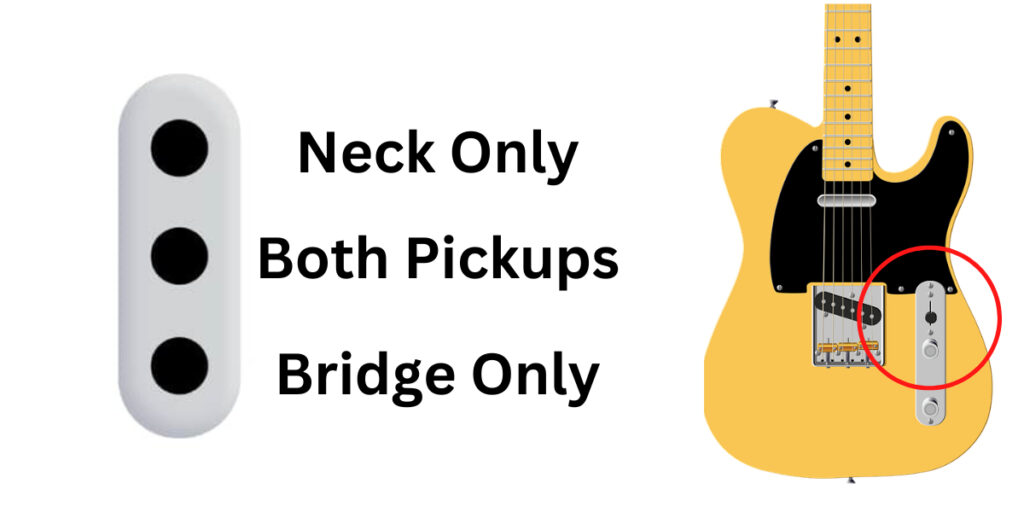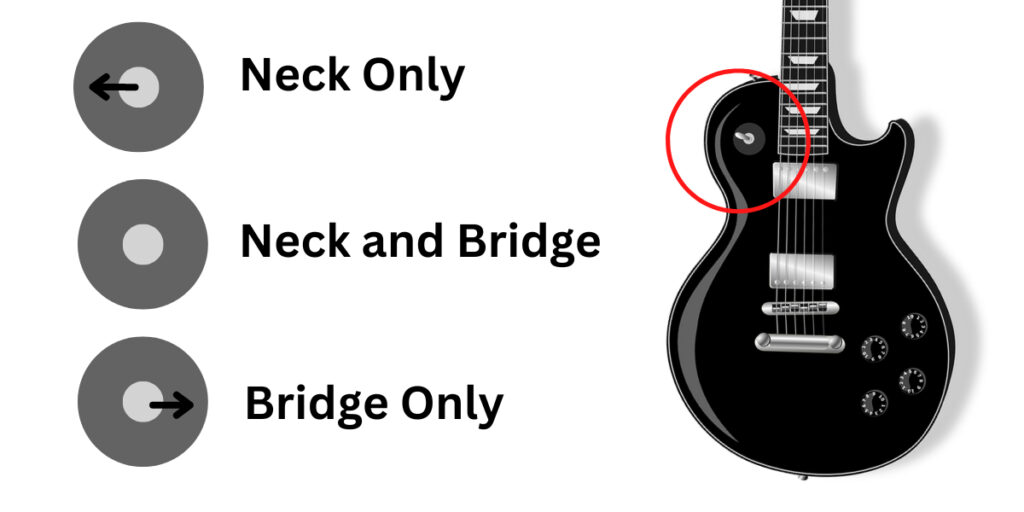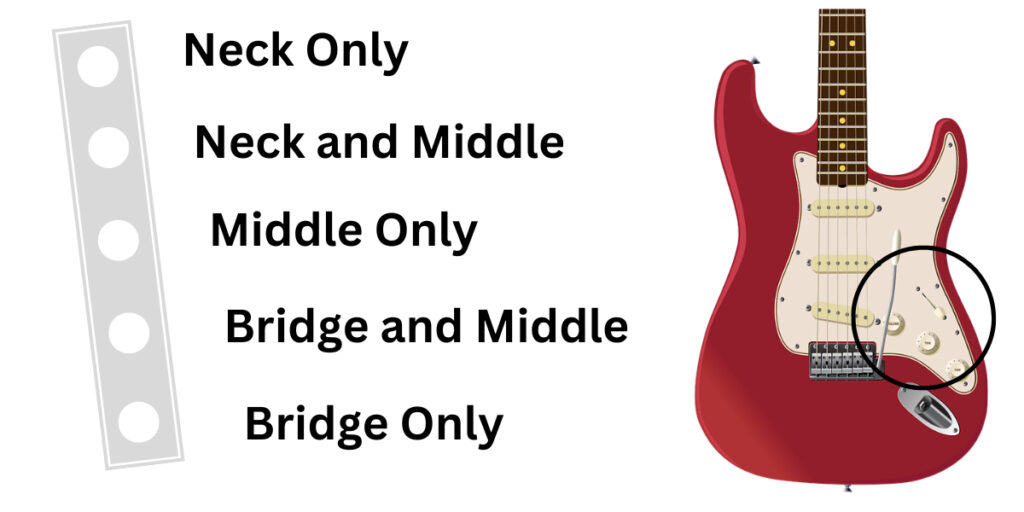There are many reasons why you might want to warm up your electric guitar’s tone. Perhaps you’re going for a thick, bluesy sound, or you just want to stop your guitar sounding harsh so you can get a better rhythm tone.
Whatever your reason is, this article will explain exactly how to make your guitar sound warm and full instead of bright and thin.
How to Make an Electric Guitar Sound Warm:
- Use the neck pickup
- Decrease the tone control on the guitar
- Decrease the treble control on the amp
- Increase the bass control on the amp
- Use a thicker and blunter pick
- Pick the strings closer to the neck of the guitar
- Slant the guitar pick
Use the Neck Pickup
Most electric guitars have either two or three pickups. The pickup position affects the way the pickup actually sounds.
Let’s consider the two pickup configuration. Here you can use the pickup selector to either activate the bridge pickup only, the neck pickup only, or both at the same time.
The bridge pickup sounds much brighter in comparison to the neck pickup which sounds warmer and more mellow. When both pickups are activated, the sound is more balanced. Some guitars such as the Stratocaster also have a middle pickup, which again sounds balanced compared to the neck and bridge pickups.
Here is a YouTube video comparing the tones of each pickup.
Check out this article comparing the bridge and neck pickup to learn more.
To activate the neck pickup, you’ll need to use the pickup selector control on your electric guitar. Here are some diagrams to demonstrate the different pickup positions and which pickups they activate.
Telecaster (2 Pickup Configuration)

Check out my Telecaster controls guide for more information.
Les Paul/ SG (2 Pickup Configuration)

Check out my Les Paul controls guide for more information.
Stratocaster (3 Pickup Configuration)
- 3 pickups (neck, middle and bridge)
- 5 possible pickup selector positions

Check out my Stratocaster controls guide for more information.
Roll Back the Tone Control on the Guitar
Pretty much every electric guitar has a tone control and a volume control. These are usually small pots located on the lower half of the guitar.
The tone control can be used to adjust the high-end (also known as treble) frequencies that pass through to the amplifier. Having more high-end frequencies causes the guitar to sound brighter, whereas having less high-end frequencies causes the guitar to sound more mellow and warm.
Turning the tone control down on your electric guitar will cause it to sound warmer as it will cut the high-end frequencies.
You can play about with this as well as your amp settings to get the right balance of warmth and brightness. Be careful about turning the tone control down too far though, as it can cause the guitar to sound a bit muddy as a lot of the definition is lost.
Most guitars label the tone control, but you can always figure out which is the volume and tone control by listening to see if there is any difference in loudness when you decrease one control. If there is, you’ll know that the other control adjusts the tone instead.
Decrease the Treble on the Amp
As I just mentioned, having the high-end, or “treble” frequencies set too high can cause the guitar to sound very bright and sometimes harsh. If you want to warm up your tone, turning the treble down is a really easy way to do it.
Most guitar amps have individual treble and bass controls which can be adjusted independently. However, some amps just have a single “tone” or “EQ” knob. In this case, on most amps you’ll need to turn this control down to tame the treble frequencies and get a warmer, smoother tone.
Some amps also have a “presence” control which adjusts the upper-mids and treble frequencies. Again, if you want a warmer tone then try turning this control down.
Check out my complete guide to the presence control to make sure you’re getting the best from it.
Increase Bass and Mids on the Amp
As well as the treble control, most amps also have independent bass and mids controls too. The bass control adjusts the low-end frequencies and the mids adjusts the (you guessed it) mid-range frequencies.
If you don’t want to turn your treble down too much as you’re finding you’re not getting enough definition, then you should also try increasing the bass setting. This helps to create a fuller and warmer sound. You can also try increasing the mids setting if you found that you need more depth and fullness.
If you need more help with your amp, check out my complete amp settings and controls guide to learn everything you need to know.
Use a Thicker and Rounder Pick
There are many different picks (plectrums) on the market and they all influence how your guitar sounds quite considerably.
Using a thicker pick will enhance the bass frequencies and make the guitar sound warmer. Thin picks on the other hand produce a brighter sound due to the lack of bass response that they create.
If you currently use a thin pick, consider increasing the thickness as this can have a significant impact on the tone. Keep in mind though that it’ll also change how the strings feel to pluck.
Check out this YouTube video where you can hear the difference between a thick and thin pick (starting with the thinnest and working up).
Some picks are also pointier than others. Pointy picks sound brighter in comparison to more rounded and blunter picks which sound warmer. Hence, you also need to consider the shape as well as the thickness when selecting a pick.
Pick the Strings Closer to the Neck
The position you actually pluck the strings on your guitar also impacts the sound. Plucking the strings closer to the bridge of the guitar causes it to sound brighter, whereas plucking the strings closer to the neck of the guitar makes it sound warmer.
Your hand is likely to naturally fall in a comfortable position, so you may not want to change it. However, if you have never tried changing your picking hand position then it’s worth trying as it may actually feel and sound better.
Slant the Pick
Decreasing the angle at which the pick plucks the strings will cause the guitar to sound warmer and fuller. Slanting the pick can help to decrease this angle and in turn give you that warm, smooth sound you’re looking for.
The only thing to keep in mind here though is that slanting the pick (rather than having it perpendicular to the strings will cause the upstrokes and downstrokes to sound quite different from one another.
Check out this YouTube video to listen to the difference.
Modifications to Make a Guitar Sound Warmer
- Use thicker strings
- Use nickel strings
- Use P90 or humbucker pickups
Thicker Strings
Thicker strings sound warmer and fuller in comparison to thinner strings. Increasing your string gauge by one size may be just what you need to achieve the tone you’re looking for. However, you should be mindful that it will also have a big impact on the feel of the guitar.
Check out my comparison between 9 and 10-gauge strings to learn more.
Nickel Strings
Most electric guitar strings are either made from steel or nickel. Steel strings sound bright and have more treble emphasis compared to nickel strings which sound warmer and more mellow. Nickel strings are popular with blues and rhythm players who prefer that warm, smooth sound.
P90 or Humbucker Pickups
Okay so this is a pretty big modification, but one that I still feel is worth mentioning.
There are three main types of electric guitar pickups:
- Single coils
- P90s
- Humbuckers
Single coils sound the brightest and thinnest and are found on guitars like Stratocasters and Telecasters. Humbucker pickups sound the warmest and fullest and are found on Les Pauls and SGs. P90 pickups are more closely related to single coil pickups, but sound warmer in comparison.
If your guitar has single coils and you find them too bright then you might want to go for a guitar with either P90 or humbucker pickups.
Check out my comparison between single coil, P90 and humbucker pickups to learn more.
